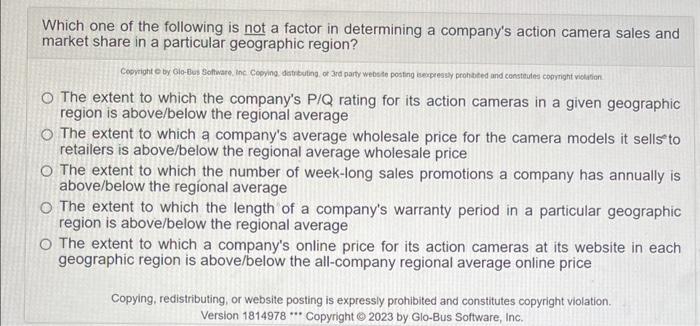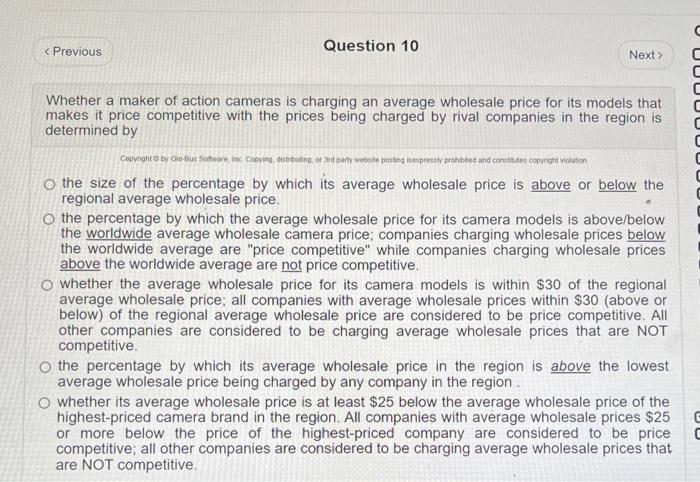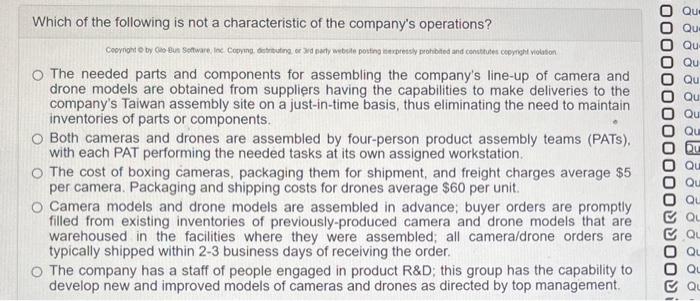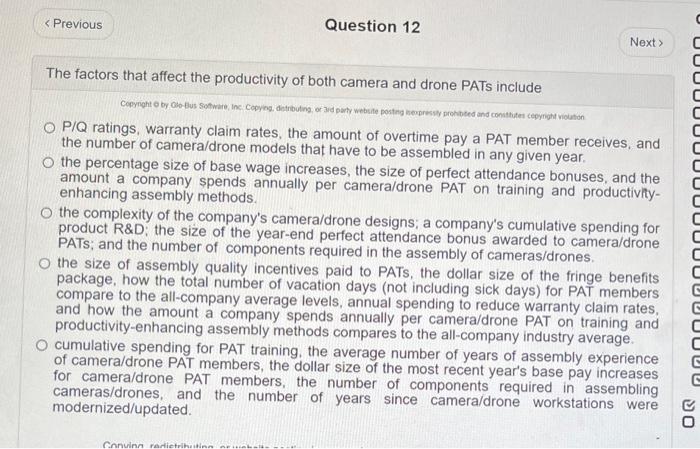Globus

Which one of the following is not a factor in determining a company's action camera sales and market share in a particular geographic region? The extent to which the company's P/Q rating for its action cameras in a given geographic region is above/below the regional average The extent to which a company's average wholesale price for the camera models it sells to retailers is above/below the regional average wholesale price The extent to which the number of week-long sales promotions a company has annually is above/below the regional average The extent to which the length of a company's warranty period in a particular geographic region is above/below the regional average The extent to which a company's online price for its action cameras at its website in each geographic region is above/below the all-company regional average online price Copying, redistributing, or website posting is expressly prohibited and constitutes copyright violation. Version 1814978 Copyright @ 2023 by Glo-Bus Software, Inc. makes it price competitive with the prices being charged by rival companies in the region is determined by the size of the percentage by which its average wholesale price is above or below the regional average wholesale price. the percentage by which the average wholesale price for its camera models is above/below the worldwide average wholesale camera price; companies charging wholesale prices below the worldwide average are "price competitive" while companies charging wholesale prices above the worldwide average are not price competitive. whether the average wholesale price for its camera models is within $30 of the regional average wholesale price; all companies with average wholesale prices within $30 (above or below) of the regional average wholesale price are considered to be price competitive. All other companies are considered to be charging average wholesale prices that are NOT competitive. the percentage by which its average wholesale price in the region is above the lowest average wholesale price being charged by any company in the region. whether its average wholesale price is at least $25 below the average wholesale price of the highest-priced camera brand in the region. All companies with average wholesale prices $25 or more below the price of the highest-priced company are considered to be price competitive; all other companies are considered to be charging average wholesale prices that are NOT competitive. Which of the following is not a characteristic of the company's operations? The needed parts and components for assembling the company's line-up of camera and drone models are obtained from suppliers having the capabilities to make deliveries to the company's Taiwan assembly site on a just-in-time basis, thus eliminating the need to maintain inventories of parts or components. Both cameras and drones are assembled by four-person product assembly teams (PATs). with each PAT performing the needed tasks at its own assigned workstation. The cost of boxing cameras, packaging them for shipment, and freight charges average $5 per camera. Packaging and shipping costs for drones average $60 per unit. Camera models and drone models are assembled in advance; buyer orders are promptly filled from existing inventories of previously-produced camera and drone models that are warehoused in the facilities where they were assembled; all camera/drone orders are typically shipped within 2-3 business days of receiving the order. The company has a staff of people engaged in product R\&D; this group has the capability to develop new and improved models of cameras and drones as directed by top management. The factors that affect the productivity of both camera and drone PATs include Copynght of by, Oib-bus sotware, inc. Copying. detributing, or 3id papty website postrig mexpressly prohibced and consthutei cepyright viouton. P/Q ratings, warranty claim rates, the amount of overtime pay a PAT member receives, and the number of camera/drone models that have to be assembled in any given year. the percentage size of base wage increases, the size of perfect attendance bonuses, and the amount a company spends annually per camera/drone PAT on training and productivityenhancing assembly methods. the complexity of the company's camera/drone designs; a company's cumulative spending for product R\&D: the size of the year-end perfect attendance bonus awarded to camera/drone PATs; and the number of components required in the assembly of cameras/drones. the size of assembly quality incentives paid to PATs, the dollar size of the fringe benefits package, how the total number of vacation days (not including sick days) for PAT members compare to the all-company average levels, annual spending to reduce warranty claim rates. and how the amount a company spends annually per camera/drone PAT on training and productivity-enhancing assembly methods compares to the all-company industry average. cumulative spending for PAT training, the average number of years of assembly experience of camera/drone PAT members, the dollar size of the most recent year's base pay increases for camera/drone PAT members, the number of components required in assembling cameras/drones, and the number of years since camera/drone workstations were modernized/updated











